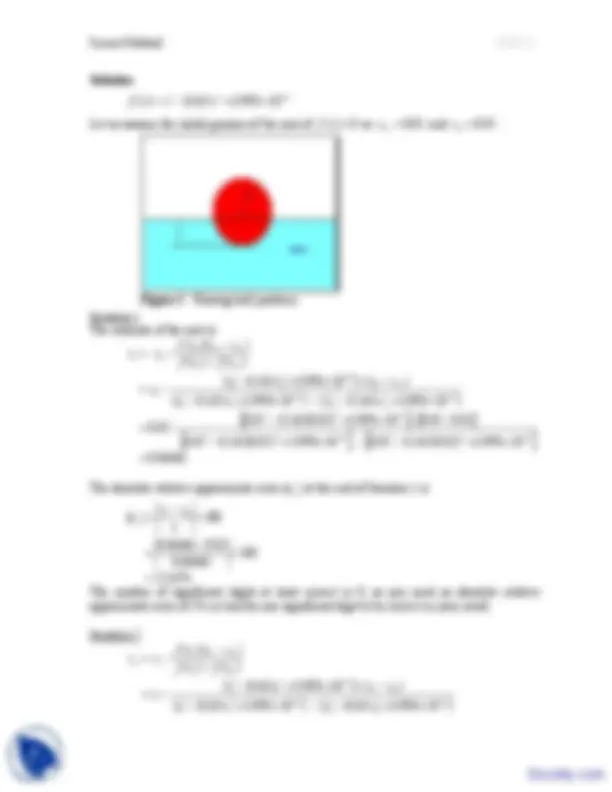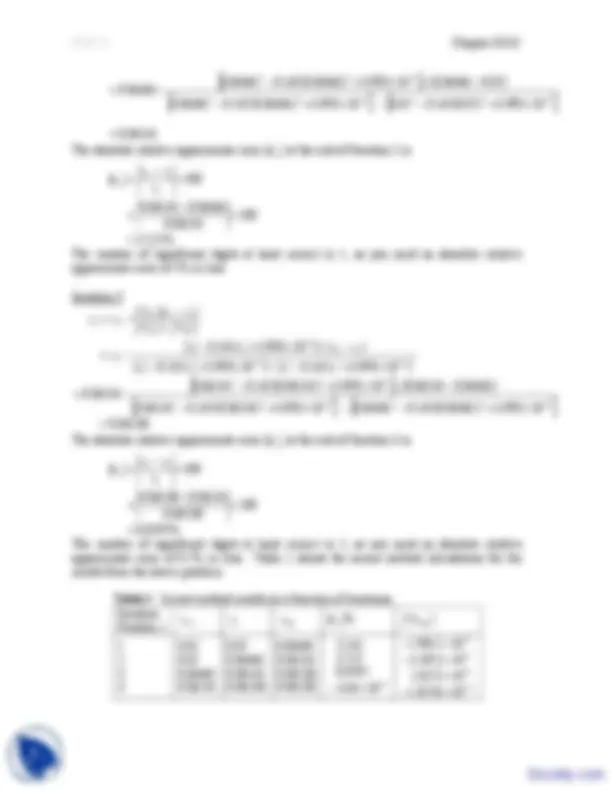




Study with the several resources on Docsity

Earn points by helping other students or get them with a premium plan


Prepare for your exams
Study with the several resources on Docsity

Earn points to download
Earn points by helping other students or get them with a premium plan
Community
Ask the community for help and clear up your study doubts
Discover the best universities in your country according to Docsity users
Free resources
Download our free guides on studying techniques, anxiety management strategies, and thesis advice from Docsity tutors
Main Points are:Secant Method, Solving Nonlinear Equations, Newton-Raphson Method, Symbolic Manipulators, Geometrical Representation, Finding Roots of Equations, End of Iteration, Function of Iterations, Significant Digits
Typology: Exams
1 / 4

This page cannot be seen from the preview
Don't miss anything!



After reading this chapter, you should be able to:
What is the secant method and why would I want to use it instead of the Newton-
Raphson method?
The Newton-Raphson method of solving a nonlinear equation f ( x ) 0 is given by the
iterative formula
1 i
i i i f x
f x x = x
One of the drawbacks of the Newton-Raphson method is that you have to evaluate the
derivative of the function. With availability of symbolic manipulators such as Maple,
MathCAD, MATHEMATICA and MATLAB, this process has become more convenient.
However, it still can be a laborious process, and even intractable if the function is derived as
part of a numerical scheme. To overcome these drawbacks, the derivative of the function,
f ( x )is approximated as
1
i i
i i i x x
f x f x f x (2)
Substituting Equation (2) in Equation (1) gives
1
1 1
i i
i i i i i f x f x
f x x x x x (3)
The above equation is called the secant method. This method now requires two initial
guesses, but unlike the bisection method, the two initial guesses do not need to bracket the
root of the equation. The secant method is an open method and may or may not converge.
However, when secant method converges, it will typically converge faster than the bisection
method. However, since the derivative is approximated as given by Equation (2), it typically
converges slower than the Newton-Raphson method.
03.05.2 Chapter 03.
The secant method can also be derived from geometry, as shown in Figure 1. Taking two
initial guesses, xi (^) 1 and xi , one draws a straight line between f ( xi ) and f ( xi 1 ) passing
through the x -axis at xi (^) 1. ABE and DCE are similar triangles.
Hence
1 1
1
1
(^) i i
i
i i
i
x x
f x
x x
f x
On rearranging, the secant method is given as
1
1 1
i i
i i i i i f x f x
f x x x x x
Figure 1 Geometrical representation of the secant method.
Example 1
You are working for ‘DOWN THE TOILET COMPANY’ that makes floats (Figure 2) for
ABC commodes. The floating ball has a specific gravity of 0.6 and a radius of 5.5 cm. You
are asked to find the depth to which the ball is submerged when floating in water.
The equation that gives the depth x to which the ball is submerged under water is given by
3 2 4
x x
Use the secant method of finding roots of equations to find the depth x to which the ball is
submerged under water. Conduct three iterations to estimate the root of the above equation.
Find the absolute relative approximate error and the number of significant digits at least
correct at the end of each iteration.
f ( x )
f ( xi )
f ( xi– 1 )
xi+ 1 xi– 1 xi
x
B
C
E D A
03.05.4 Chapter 03.
3 2 4 3 2 4
3 2 4
The absolute relative approximate error a at the end of Iteration 2 is
2
2 1
x
x x a
The number of significant digits at least correct is 1, as you need an absolute relative
approximate error of 5% or less.
Iteration 3
2 2 1 3 2 f x f x
f x x x x x
2 4 1
3 1
2 4 2
3 2
2 1
2 4 2
3 2 2
x x x x
x x x x x
3 2 4 3 2 4
3 2 4
The absolute relative approximate error a at the end of Iteration 3 is
3
3 2
x
x x a
The number of significant digits at least correct is 2, as you need an absolute relative
approximate error of 0.5% or less. Table 1 shows the secant method calculations for the
results from the above problem.
Table 1 Secant method results as a function of iterations.
Iteration
Number, i
4
5
7
9
13